The Amalfi Coast
The first sight of Positano on southern Italy’s Amalfi Coast is one to take your breath away. The pastel coloured buildings piled up the hillside over the crystal blue ocean below has been photographed many a time, but it never quite prepares you for when you see it yourself. The Amalfi Coast is one of Italy’s tourism gems, and justifiably so; just two hours south of Rome, you can find yourself a world away from the hustle-bustle of the big city.
We set out from Rome’s second airport, Ciampino, in our Mercedes C-class on Wednesday morning after a bit of trouble finding the Hertz counter in the airport car park. We had booked the car from the airport on the outskirts of the city, knowing that driving in Rome would test our skills and patience. Driving on the right side of the road isn’t particularly difficult; it’s just the same, and turning a corner on to the opposite side of the road feels strangely logical. What is difficult is changing your instinctive actions; like going to grab the gear stick with your left hand, when it now appears on the right, or judging the distance between the passenger side of the car and the kerb, when that is now on the opposite side. Leaving Rome, we opted for the ‘scenic route’ south from Rome to Naples, along the coast via Latina and a couple of smaller towns – we needn’t have bothered. The largely industrial towns along this route were ugly, and very rarely we near the actual coast. It took twice as long as the ‘autostrada’ A1 (motorway) would have,
and we were delayed even further by a dodgy GPS system when we arrived in the tangle of roads that is Naples. Before you get too excited, don’t expect anything beautiful from Naples, the regional capital near the Amalfi Coast. Naples is a big, dirty, shabby port city with too much rubbish and not enough footpaths. But more on that later – we eventually swung around towards the coast and entered the narrow twisting corridor of roads between the Sorrento Peninsula and the Bay of Naples. Sandwiched between the road and the coast was our hotel – the fairly average Crowne Plaza. Designed for package tourist buses, the Crowne Plaza is excellently located for excursions out to the surrounding regions. We spent the afternoon wandering around the hotel grounds, along the coast, and watching a storm roll in over the imposing Mount Vesuvius from across the bay.
On Thursday morning we set out for breakfast in the seaside resort town of Sorrento. While the bay seemed to be experiencing clear weather, the peninsula where we were staying (and visiting) was covered with heavy, menacing clouds. From the west coast of Italy, the Sorrento Peninsula stretches out almost at a right angle. On the northern side of the peninsula, facing Naples and Mount Vesuvius, lies Castellamare di Stabiae, where our hotel was, and Sorrento. The mountainous peninsula hems in these towns, and every bit of flat land is precious; the roads consist of two narrow lanes only, and are accompanied by a railway line whose tunnel weaves in and out of the folds of the mountain. The increase in traffic on these roads has clogged them and turned the 14 kilometre drive from Castellamare di Stabiae to Sorrento into a one hour crawl. The scenery however gets increasingly prettier as your drive along; lots of beautiful villas perched atop sheer rocky cliff faces. Eventually we arrived in Sorrento; on Via Della Aranci we found a parking lot in which to leave our ride and explore on foot. Sorrento is as gorgeous as one would expect; tight laneways adorned by citrus trees opening out on to leafy piazzas. The sun soaked yellow and rust coloured walls were dotted with small paintings and mosaic tiles formed into pretty artworks; many houses used such mosaics to display their street number or name. Small boutiques and craft shops spilled out into the alleys where the locals scooted around on Vespas, while others still hung out their washing and tended to their gardens from second, third and fourth storey windows. Breakfast consisted of a chocolate brioche and cappuccino at the café on the north side of Piaza Tasso – next to
the escarpment. On a warmer day we could’ve sat out on the balcony by the escarpment, where vines hung over the walls, which featured various sculptures and etchings, evidence of Sorrento’s rich history.
After exploring Sorrento further, we struck out for the Amalfi Coast on the southern face of the peninsula. The road climbed quickly, up and over the mountainous ridge, before gradually descending towards the Mediterranean once again. It was there that the curves began – the twisting and turning road along the Amalfi Coast affords excellent views, and many of the bends feature small turnouts for sightseeing tourists to stop. The light electric blue of the water contrasted brilliantly in the sunlight with the verdant green of the coast and the neutral greys of the rocky castles built along it. As we approached Positano small produce stalls began appearing along the roadside, selling all sorts of
citrus fruits, lemon cordials, cherries, and locally grown tomatoes, garlic, onions and peppers. And finally, there it was. We rounded a corner and allowed our eyes to trace the road, over the rocky bridges built into the hillside, to the towering settlement of Positano. Of course, that was the moment that the heavens decided to open up, and after finding parking in a small garage on the way into town we took shelter under the alcove of a house built into the side of the hill. With the passing rain shower over, we resumed our descent to the seaside town. Positano’s centre is just a few metres back from the beach, but we got distracted by a cute laneway on the way down. Turning right after a small carved rock grotto, we took the backalleys down to the beach below. Lined by pensione (bed and breakfasts), these lanes form the bulk of a town where space is at a premium. Soon we were down on the beach, and trudging our way across to the town centre.
Positano’s town centre feels a lot like one of those touristy areas which had gone upmarket but still retains a chilled out vibe, much like Australia’s Byron Bay. Boutique sweet shops, handicraft stalls and outlets selling peasant-chic ladiesware abound, although there the similarities end. Steps and ramps between parts of Positano create a toy-town like atmosphere, and not a single inch of land is wasted. We ambled around the church and a couple of the shops, before beginning our way back to the car, winding our way back up the street. Positano features one road through it. Owing to space limitations it is a one-way street, so if you miss your address you are required to head back up the hill to the highway and start again. Climbing back up the road by foot is a rewarding experience though – not as steep as the steps, and bordered by trattoria and cafes, mostly offering sweeping vistas of the spectacular town and surrounding coastline. We stopped in at one for a
drink; the dappled light of the sun filtering through the colourful vines which grew through the trellis above. The day had cleared up and we took advantage of this to finish our tour of the Amalfi Coast. As we continued, we passed more towns built into side of the hill, but none quite as spectacular as Positano. Rounding out the end of the coast, we arrived in the large town of Salerno before joining the motorway to scoot across the mountains into Naples.
Known as Napoli to locals, settlement has existed in this area for at least 2000 years. Naples is the home of pizza, for it was here in 1889 that a local baker put tomato, mozzarella and basil leaves on bread for the first time. It was reportedly created to resemble the colours of the Italian flag, and it was named after Queen Margarita. (To be fair, Italians and Greeks had been putting olive oil and oregano on warm
bread for centuries before, but Naples was the birthplace of pizza as we know it today). The rustic margarita pizza is still the preferred variety here – the concept of pizza had to get exported to the USA in the 1940s before varieties like Hawaiian and Meatlovers were invented. We had a quick dinner in Naples before escaping the city which our guidebook described as a “raucous hell-broth”. They weren’t wrong either; Naples traffic is unruly, the streets frenetic, and the city centre chaotic. Out of the centre, large areas of the city lie in decay, with graffiti, abandoned warehouses and unmaintained roads the norm. It looks a bit like life after an apocalypse, not helped by the piles of uncleared rubbish everywhere. Due to a bureaucratic dispute between contractors and the city council, Naples went for a period without garbage collection between 2010 and 2012. The rubbish is slowly being cleared up, but outside the CBD there is still evidence of the piles of trash which until recently filled the streets. So bad was the crisis that some streets couldn’t be navigated by a car because of the bags of refuse just sitting around, and in 2012 a new breed of cockroach was detected, living amongst the trash. It’s difficult to believe that such a situation would exist in a developed nation in 2012.
On Friday morning we drove back into the urban decay of Naples to the suburb of Pompei, better known for its old city which lies in ruins after being destroyed by a volcano 2000 years ago. Although modern Pompei (sometimes spelled Pompeii) is a working-class town enveloped by Naples’ urban sprawl, the ruins have been preserved magnificently, with actual houses, roads and courtyards still visible. It’s so easy to imagine the city in its heyday, with people going about their lives before the fateful moment when Mount Vesuvius erupted. What is most astounding about the ancient city of Pompei is the size of it; the city was so extensive, built over hills for blocks and blocks. The most affecting sight is easily the preserved bodies of actual people who were frozen in time when the lava rained down on them. Some appear to be clutching at their terrified faces, apparently being asphyxiated by the ash cloud.
Much like Rome, the area around the Amalfi Coast lives with one foot in the past and one foot in the present. The real test will be if today’s history lasts as long and in such a tangible way 2000 years from now.
When to go
Summer in Europe rocks – come in June, July or August and watch the coast glitter!
Essential Stats
Culture shock: 6/10
Language difficulty: 5/10
Quality of food: 8/10
Physical demand: 5/10 (especially the steps at Positano)
Advice and warnings
Parts of Italy have a problem with theft, particularly pickpocketing from tourists during busy seasons. Keep a close eye on all your valuables. Some cities impose a bed tax on certain categories of hotel rooms – check with your accommodation when booking.
Check Smart Traveller or the British Foreign Office for more comprehensive warnings.
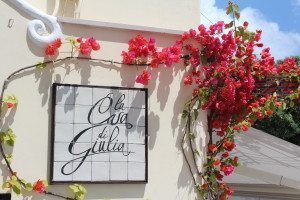 Visas
Visas
Most Australians may enter Italy without the need for a visa, but Pakistanis and Indians must apply for a Schengen visa, which grants entry to several European countries which are part of the Schengen agreement. Pakistanis must pay PKR 7740 – the process takes around one month. Applications in India cost around INR 4325, and take less than 15 business days to process. Apply through your nearest Italian diplomatic mission (Islamabad, Mumbai).
Getting there and around
From Melbourne, Lahore, Sydney and Chennai, Emirates flies to Rome via Dubai.
Melbourne from $1980 return
Lahore from PKR 101,790 return
Sydney from $1998 return
Chennai from INR 55,578 return
From Rome, one can either hire a car and drive to Naples like we did (around two hours), or jump on a train for an hour. Tickets start from US$13 and can be booked through ItaliaRail.
Accommodation
Budget options can be booked through Hostelworld, while midrange options are available through websites such as Expedia. We stayed at the 4-star Crowne Plaza Sorrento Coast.


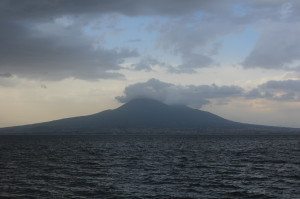
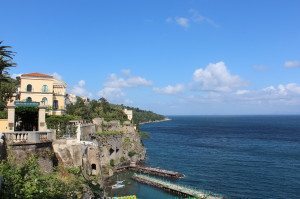
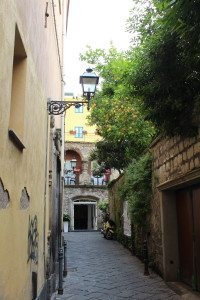
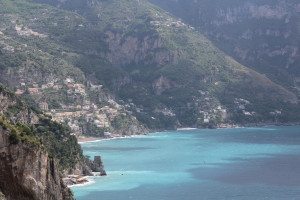
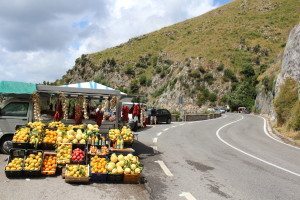
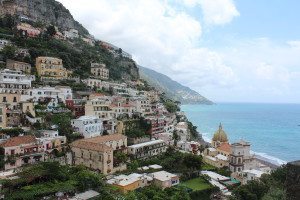
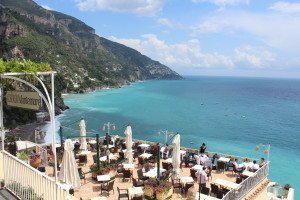
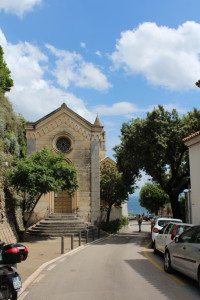
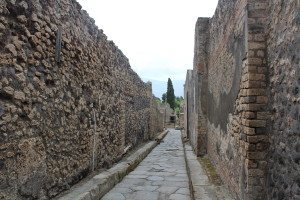
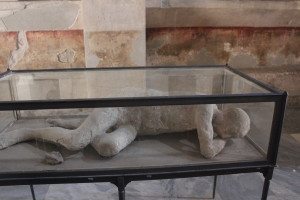



I’m already in love with Sweet Sorrento scenery. Take me there with you next time!!
You’re welcome!!! And then I’ll join you on the next trip, to Amsterdam or China!!
Wow!!!
How to start a conversation: I’m loving your articles on this trip! Your words relive my visit to the coast @ Pompei, excited for your next update!
Deb
Thanks for reading, Deb!! The next instalment from Tuscany is coming tonight!!